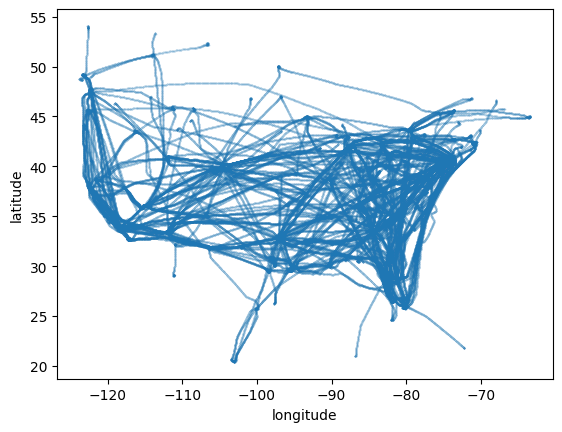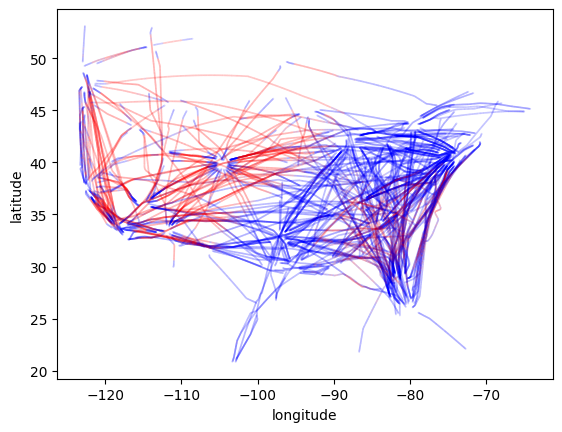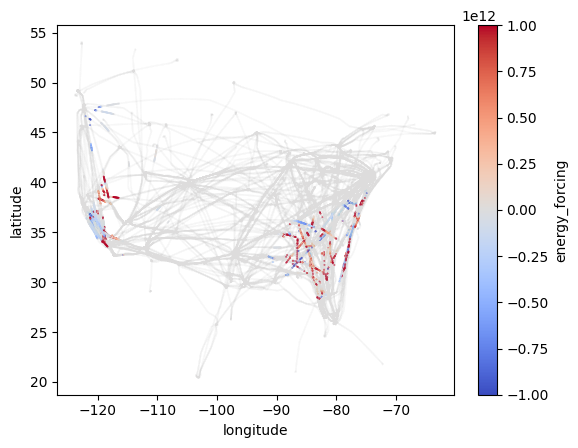Fleet Computation¶
The /trajectory endpoints in Contrails API were designed to evaluate a scientific model over a single flight. Here, a flight is a sequence of discrete temporal spatial points defining the 1-dimensional path of a flight.
A common use-case evaluates a scientific model over a collection flights (hereby dubbed a fleet). This can be achieved through this API by simply sequentially calling an endpoint for each flight in the fleet. In most cases, this sequential computation is not optimal.
Many computations in the backend can be performed substantially faster if run in tandem rather than sequentially over distinct flights. To this end, Contrails API supports fleet computation. A sequence of flights can be concatenated into a single POST request body for ingestion by the API. An additional flight_id field is required to decompose the fleet object into individual flights. In general, this mode of computation will be nearly as fast as if calling the API with a single flight
trajectory.
This notebook demonstrate best practices for fleet computation in Contrails API.
[1]:
import os
import matplotlib.colors as mcolors # pip install matplotlib
import pandas as pd # pip install pandas
import requests # pip install requests
[2]:
# Define credentials
URL = "https://api.contrails.org"
API_KEY = os.environ["CONTRAILS_API_KEY"] # put in your API key here
HEADERS = {"x-api-key": API_KEY}
Create a fleet¶
Here, we load a sample fleet of pre-cleaned flight trajectories from 2023-02-10. This sample is available for download as a CSV file.
[3]:
df = pd.read_csv("../_static/fleet_sample.csv")
df.head()
[3]:
| flight_id | engine_uid | aircraft_type | longitude | latitude | altitude | time | |
|---|---|---|---|---|---|---|---|
| 0 | b5ad83811c43ba5ad584eda8c4b6d836 | 01P10IA020 | A319 | -74.178192 | 40.684994 | 12.0 | 2023-02-10T19:48:40Z |
| 1 | b5ad83811c43ba5ad584eda8c4b6d836 | 01P10IA020 | A319 | -74.177826 | 40.685491 | 12.0 | 2023-02-10T19:49:00Z |
| 2 | b5ad83811c43ba5ad584eda8c4b6d836 | 01P10IA020 | A319 | -74.177460 | 40.685989 | 12.0 | 2023-02-10T19:49:20Z |
| 3 | b5ad83811c43ba5ad584eda8c4b6d836 | 01P10IA020 | A319 | -74.177424 | 40.686048 | 12.0 | 2023-02-10T19:49:40Z |
| 4 | b5ad83811c43ba5ad584eda8c4b6d836 | 01P10IA020 | A319 | -74.177387 | 40.686107 | 12.0 | 2023-02-10T19:50:00Z |
[4]:
df.plot.scatter("longitude", "latitude", s=0.1, alpha=0.3);

[5]:
print(f"Number of flights: {df['flight_id'].nunique()}")
print(f"Number of waypoints: {len(df)}")
# Convert to dictionary form expected by the API
request_json = df.to_dict("list")
Number of flights: 500
Number of waypoints: 184910
POST the fleet to the /trajectory/sac endpoint¶
In the API, fleet computation is enabled by including a flight_id field int the request body. Each /trajectory endpoint supports fleet computation. Here we pass our fleet into the /trajectory/sac endpoint.
Even though our fleet contains several hundred flights, the API computes the SAC in nearly the same time it would take for it to compute SAC over an individual flight.
[6]:
# Expect the request to take ~1 minute
r = requests.post(f"{URL}/v0/trajectory/sac", json=request_json, headers=HEADERS)
print(f"HTTP Response Code: {r.status_code} {r.reason}")
r_json = r.json()
HTTP Response Code: 200 OK
[7]:
# Plot the response
tmp = df.assign(sac=r_json["sac"])
cmap = mcolors.ListedColormap(["blue", "red"])
tmp.plot.scatter(x="longitude", y="latitude", c="sac", cmap=cmap, s=0.1, alpha=0.1, colorbar=False);

POST fleet to the /trajectory/cocip endpoint¶
The CoCiP model is more computationally intense than the SAC. Still, fleet computation is substantially faster than running each flight through the API sequentially. We pass our fleet into the /trajectory/cocip endpoint.
[8]:
# Expect the request to take 2 - 3 minutes
r = requests.post(f"{URL}/v0/trajectory/cocip", json=request_json, headers=HEADERS)
print(f"HTTP Response Code: {r.status_code} {r.reason}")
r_json = r.json()
HTTP Response Code: 200 OK
[9]:
# Plot energy forcing
tmp = df.assign(energy_forcing=r_json["energy_forcing"])
tmp.plot.scatter(
x="longitude",
y="latitude",
c="energy_forcing",
cmap="coolwarm",
vmin=-1e12,
vmax=1e12,
s=0.1,
alpha=0.02 + 0.9 * (tmp["energy_forcing"].abs() > 1e10).astype(float),
);

Other considerations¶
Constraints¶
In addition to all of the constraints already in place for “flight computation” (see the Trajectory schema in the api docs), several additional constraints are included for “fleet computation”.
The total duration (difference between extreme times) is at most 24 hours
The fleet is comprised of at most 1000 flights.
The fleet has no more than 300,000 waypoints.
It’s possible that the API will return a
500error if all of its memory is consumed by fleet computation. In this case, the fleet should be broken into smaller chunks and POSTed to the API sequentially.
Scalar values and aircraft performance¶
When passing in a single flight into the API, many fields can be defined by scalar or vector quantities. For example, fields such as aircraft_type, engine_uid, or wingspan are constant for a single flight, and so the API expects a single value (as opposed to an array) to be included in the request payload. When using the API for fleet computation, these values may vary over different flights. Consequently, an array of values may be included in the request body (as we’ve done in this
example notebook with aircraft_type and engine_uid).
Independence of computational mode¶
We expect flight and fleet computation to give identical results. Fleet computation simply provides a speedup.